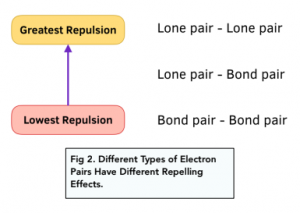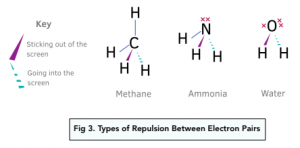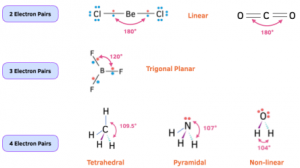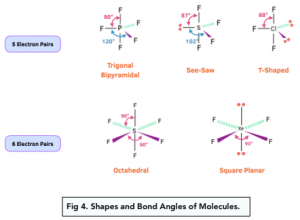Bonding - Molecular Shapes (A-Level Chemistry)
Molecular Shapes
Electron Pairs
- The central atom is the atom that every other atom is bonded to. The central atom forms covalent bonds with all the other atoms involved in the molecule
- The shape of a molecule is determined by electron pairs around a central atom. The number of electron pairs found in the outermost shell of a central atom determines the shape of a molecule or ion.
- The electron pairs can either be lone pairs or bonding pairs. The electron pairs found around the central atom can either be lone pairs or bondings pairs. A lone pair of electrons is a pair of electrons that are not shared with another atom in a bond. A bonding pair of electrons is a pair of electrons that are shared between two atoms in a bond.

Electron Charge Clouds
- An electron charge cloud is a region where there is high chance of an electron pair being present. An electron charge cloud is a region of negative charge around the nucleus and it is linked to an atomic orbital.
- An electron charge cloud can contain either bonding pairs or lone pairs of electrons. Any electron pair in the outermost shell of an atom can exist as an electron charge cloud. It does not matter whether the electron pair is involved in a bond or not.
- Electron charge clouds are as far apart as possible to minimise repulsion. Electron charge clouds are regions of negative charge where electron pairs are found. Remember that like charges repel so electron charge cloud will repel each other.
- Lone pair electron charge clouds repel more than bonding pair electron charge clouds. Lone pairs of electrons are held a lot closer to the central atom than bonding pairs of electrons are. Their electron charge clouds are more concentrated and wider. This means that the repelling effect of lone pairs is a lot stronger than that of bonding pairs.
- The bond angle between two lone pairs of electrons is the greatest. The greater the repulsion force between two pairs of electrons, the more far apart the two pairs of electrons will be and hence the larger the bond angle between them. As lone pairs of electrons have the strongest repelling effect, there is the greatest bond angle between them.


VSEPR (Valence-Shell Electron-Pair Repulsion Theory)
The concepts above are collectively known as the VESPR theory.
The VESPR Theory sustains that the number of electron pairs found in the outermost shell of a central atom determines the shape of a molecule or ion. Electron pairs will be pushed apart by the repulsive forces between them until these are minimised, hence affecting bond angles and molecular shape.
Predicting Shapes of a Molecule
You can predict the shape of a particular molecule by considering the number of electron pairs present around the central atom. Remember to consider how many lone pairs of electrons and bonding pairs of electrons are present.
To predict the shape of a molecule follow the following method:
1. Identify the central atom.
2. Count the number of outer shell electrons of this atom. In order to do this you should first write down the total number of electrons in the outermost shell of the central atom. This will be the same as the group number the element is found in.
3. Add one electron for each bond that the central atom makes with other atoms. This accounts for the electron provided by the other atom in the bond.
4. Add or subtract electrons if ion charges are present. If a negative charge is present, you should add an electron but if a positive charge is present, you should subtract an electron.
5. Find the total number of electron pairs. Do this by dividing the total number of electrons electrons calculated by 2, as two electrons are found in each electron pair.
6. Find how many of these electron pairs are bonding pairs and are lone pairs. Remember that lone pairs exert a greater repulsive force than bonding pairs.
7. Use this number to predict the shape.
Different Molecular Shapes
You need to learn the following shapes of molecules as well as the types and numbers of electron pairs present:


Practice Question: What is the shape of the molecule NH3?
1. Identify the central atom.
The central atom is nitrogen.
2. Count the number of outer shell electrons of this atom.
Nitrogen has 5 electrons in its outermost shell because it is found in Group 5 in the periodic table.
3. Add one electron for each bond that the central atom makes with other atoms.
There are three other atoms of hydrogen bonded to nitrogen. This means that the total number of electrons around the central atom of nitrogen is (5+3) = electrons
4. Add or subtract electrons if ion charges are present.
There are no ion charges involved.
5. Find the total number of electron pairs.
There are four pairs of electrons as 8 ÷ 2 = 4
6. Find how many of these electron pairs are bonding pairs and are lone pairs.
Nitrogen forms three bonds with three hydrogen atoms. This means there are three bonding pairs and one lone pair of electrons.
7. Use this number to predict the shape.
The molecule has 3 bonding pairs and 1 lone pair of electrons which means it has a trigonal pyramidal shape with a bond angle of 107°.

FAQs
In A-Level Chemistry, molecular shapes refer to the three-dimensional arrangement of atoms in a molecule. The shape of a molecule is determined by the relative positions of the atoms, which are determined by the arrangement of the electron pairs around the central atom.
The shape of a molecule is important because it affects the molecule’s physical and chemical properties. For example, the shape of a molecule can affect its polarity, which in turn can affect its solubility, boiling point, and reactivity.
There are several different molecular shapes, including linear, trigonal planar, tetrahedral, trigonal bipyramidal, and octahedral. These shapes are determined by the number and arrangement of electron pairs around the central atom.
The molecular shape can be determined by following these steps:
Determine the Lewis structure: Draw the Lewis structure of the molecule, which shows the arrangement of the atoms and the lone pairs of electrons around the central atom.
Count the total number of electron pairs: Count the total number of electron pairs around the central atom, including both bonding pairs and lone pairs of electrons.
Determine the electron pair geometry: Use the Valence Shell Electron Pair Repulsion (VSEPR) theory to determine the electron pair geometry, which is the arrangement of the electron pairs around the central atom in three-dimensional space. The electron pair geometry is determined by the number of electron pairs, regardless of whether they are bonding or lone pairs.
Determine the molecular geometry: Determine the molecular geometry, which is the actual arrangement of atoms in the molecule. The molecular geometry is determined by the positions of the atoms only, ignoring the lone pairs of electrons.
Identify the bond angles: Finally, identify the bond angles between the atoms in the molecule. The bond angles are determined by the positions of the atoms in the molecular geometry.
Bonding in chemistry refers to the process by which atoms join together to form molecules.
The different types of bonding include covalent bonding, ionic bonding, and metallic bonding.
Covalent bonding is a type of bonding where atoms share electrons in order to form a chemical bond.
Ionic bonding is a type of bonding where atoms transfer electrons to form ions, which are then attracted to each other to form a bond.
Metallic bonding is a type of bonding where metal atoms share a pool of electrons, resulting in a bond that is strong and conductive.
The type of bonding between atoms in a molecule determines the molecular shape. For example, covalent bonding results in the formation of molecules with defined shapes, while ionic bonding results in the formation of compounds with more structured, lattice-like shapes.
The type of bonding between atoms in a substance affects its physical properties, such as its melting and boiling points, solubility, and conductivity. For example, ionic compounds tend to have high melting and boiling points, are usually soluble in water, and are poor conductors of electricity. Covalent compounds, on the other hand, tend to have lower melting and boiling points, are usually insoluble in water, and are poor conductors of electricity.
The VSEPR (Valence Shell Electron Pair Repulsion) theory is a model used to predict the shape of molecules based on the repulsion between electron pairs in the valence shell of the atoms.
The VSEPR theory helps to explain molecular shapes by predicting the arrangement of electron pairs in the valence shell of atoms, and how they repel each other to determine the final molecular shape.
Yes, molecular shapes can be changed by changing the type of bonding between atoms. For example, converting ionic bonds to covalent bonds can result in a change in the molecular shape.
Understanding molecular shapes is important in A-Level Chemistry because it helps to explain the physical and chemical properties of substances, as well as their reactivity and interactions with other substances. This knowledge is essential for a wide range of applications, from drug design to the development of new materials.






Still got a question? Leave a comment
Leave a comment